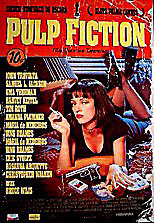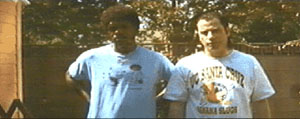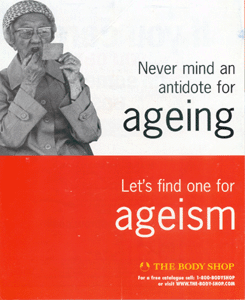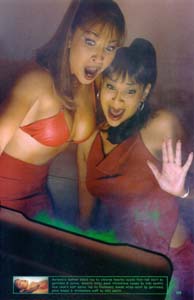This unit on understanding stereotypes in the media will have
three topics:
What,
then, are stereotypes (1)?
|
...assumptions and beliefs about the
physical, behavioral, and psychological characteristics
assigned to a particular group or class of people...
(Cyrus 65)
|
Examine the images and dialogue from Pulp Fiction
to determine if any stereotypes are used.
 |
|

 Listen
to the dialogue. Click on the picture to play the selection
as many times as you wish. Listen
to the dialogue. Click on the picture to play the selection
as many times as you wish. |
| |
| Discussion: Why do you think the people
who designed the poster for Pulp Fiction chose the
specific content they did. Why is the poster formatted as
a 10 cent comic book? What makes the image of the woman
a stereotype? What stereotype is it? How can you tell? |
|
Have you ever felt you had to laugh when a
stereotype in used in a joke even though you didn't want
to? How does the laughing in the Pulp Fiction dialogue
function? Does laughing make you complicit in the stereotyping
that's going on? What could you do instead of laughing?
|
Discussion: In light of the definition
of stereotypes above, what are the physical, behavioral, and
psychological traits associated with "dorks?" Are
those traits linked to any particular group of people? Can any
person of any age, class, race, or gender be labeled a dork?
Why or why not?


USM assignment 1: Study
the handout on stereotypes and
summarize what a stereotype is in your own words. Bring
your summary statement into class.
 |
Do you find these images stereotypical?
Why or why not? How can you tell? |
 |
| |

 Contextual analysis (2):
To figure out if something is a stereotype we need to put it
in a context.
Contextual analysis (2):
To figure out if something is a stereotype we need to put it
in a context.
To get a different perspective on Obsession ads go to this website:
 Link
to Adbusters for alternative Obsession ads. http://www.adbusters.org/uncommercials/obsession/index.html
Link
to Adbusters for alternative Obsession ads. http://www.adbusters.org/uncommercials/obsession/index.html
In Philosophical Issues in Prejudice and
Discrimination, we need to cast our analytical nets very wide,
out from a family and individual context to a social, historical
and political context.
 |
Exercise 3 at the  bottom
of this unit will help you put issues facing individuals
into a global context. bottom
of this unit will help you put issues facing individuals
into a global context.
The opportunities facing the child in Iraq and the children
in US schools are quite different.
|
|


John Berger uses an intellectual context
to examine the sexual objectification of women in advertising.
He develops a phenomenological approach through a philosophical
analysis of women's consciousness.
 |
A woman has a split self - herself watching
herself being herself - the surveyor and the surveyed. (Berger
46) |
You will see questions about his theory in Exercise
6 at the  bottom of this unit.
bottom of this unit.
Media
literacy (3):
 Media
literacy is the ability to access, analyze, critically
evaluate, and produce communication in a variety of forms.
|
How many forms of media have you encountered so
far today? Brainstorm a list of them now. Bring your
list to class.
For Prejudice and Discrimination we will concentrate
on media literacy as critical analysis and advocacy.
Five Principles
of Media Literacy:
- Media messages are constructed.
- The media construct reality.
- Different people experience the same media message in different
ways.
- Media are primarily businesses driven by a profit motive.
- Media have embedded values and points of view.
Link to a brief explanation of each of these
principles from the Ontario Ministry of Education.


Questions like the following are suggested
by media literacy experts to analyze any piece of media:
- Who is "speaking" and what is their purpose? (Who
produced or sponsored the message?)
- Who is the target audience, and how is the message specifically
tailored to them?
- What techniques are used to attract attention?
- What values and lifestyles are promoted? (What is communicated
as good to be, or have, or do? What is not good to be, or
have, or do?)
- What is implied without being specifically stated (especially
about the credibility of the message)?
- What is left out of this message that might be important
to know?
From Project Look Sharp, Ithaca College. Check out their web
site, especially if you want to be a teacher! http://www.ithaca.edu/looksharp


Practice your media literacy skills by deciding what
sort of contextual analysis of stereotyping the Burnsville Athletic
Club used to make its decision?
|
Victory in Burnsville, Minnesota, against racist
stereotypes of Indians Minneapolis: In the Minneapolis
suburb of Burnsville , the Board of Directors of the
Burnsville Athletic Club (BAC) on July 11, 1999 adopted
team-naming guidelines, according to which it �will
not employ a mascot, emblem, name, logo, or official
symbol which is considered potentially discriminatory
and/or offensive to an individual or group (i.e. gender,
race, religion).� In a separate resolution applying
these guidelines, the BAC board specifically dropped
the names �Indians,� �Braves� �Warriors� �Redskins�
�Chiefs� currently in use in its sports clubs roster
of over 100 teams. The BAC has a semiofficial role in
Burnsville and the surrounding communities in organizing
sports activities and providing team uniforms and paraphernalia.
http://global-reach.com/cp-minn/bac.htm
|
Understanding Stereotypes in the media (USM):
unit assignments
USM assignment 2: Visit the following
website and scan some of the articles:
http://www.uiowa.edu/~commstud/resources/GenderMedia/advertising.html
 Send me an email about what you learned from the articles. Focus
on how women and people of color are portrayed in the media stereotypically.
Send me an email about what you learned from the articles. Focus
on how women and people of color are portrayed in the media stereotypically.
USM assignment 3:
Sexual objectification exercise
USM assignment 4: Political
and economic contexts
USM assignment 5:
Name that context quiz
USM assignment 6:
Cultural definitions of men and women
USM assignment 7:
 |
Click on the picture to the left for a larger
version and to answer some questions.
|
USM assignment 7:
Humorous Quotes
USM assignment 8: Repeat
USM assignment 3 using the 5
principles and 6 questions above.
 Send
an example to the class archive!
Send
an example to the class archive!

